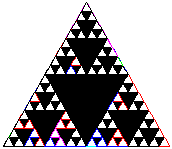 great pyramid, Egypt
great pyramid, Egypt Pyramids, Triangles, and Aristotle's appeals
Trigonometry , branch of mathematics that deals with the relationships between the sides and angles of triangles and with the properties and applications of the trigonometric functions of angles.
The earliest applications of trigonometry were in the fields of navigation , surveying , and astronomy , in which the main problem generally was to determine an inaccessible distance, such as the distance between the earth and the moon, or of a distance that could not be measured directly, such as the distance across a large lake. Other applications of trigonometry are found in physics, chemistry, and almost all branches of engineering, particularly in the study of periodic phenomena, such as vibration studies of sound, a bridge, or a building, or the flow of alternating current.
Triangles are the only rigid polygon, which makes them quite useful for construction.
 great pyramid, Egypt
great pyramid, Egypt
 serpinski's triangle. Fun with fractals
serpinski's triangle. Fun with fractals
 El Castillo (the castle) Chichen Itza, Yucatan Mexico
El Castillo (the castle) Chichen Itza, Yucatan Mexico
 dollar bill : Great seal of the United States
dollar bill : Great seal of the United States

". . .When these pyramids are mapped, we just may find that some are aligned to constellations important to the ancient Chinese, much like the Giza pyramids are aligned to the three belt stars of the constellation Orion" ---- Laura Lee
Rocky Mountain News article, 1947.

As with other continents, the mounds and pyramids of North America vary greatly. It could be that humankind has a primal need to build fake mountains, and that there are absolutely no connections between these sites. Or perhaps size and shape are irrelevant, and location is everything, and the guidelines for their placement was once universally known.
. . . Which leads us to the Rhetorical Triangle
and more ........